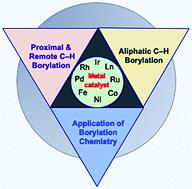当前位置:
X-MOL 学术
›
Chem. Soc. Rev.
›
论文详情
Our official English website, www.x-mol.net, welcomes your
feedback! (Note: you will need to create a separate account there.)
Metal-catalysed C–H bond activation and borylation
Chemical Society Reviews ( IF 40.4 ) Pub Date : 2022-05-30 , DOI: 10.1039/d1cs01012c Ranjana Bisht 1 , Chabush Haldar 1 , Mirja Md Mahamudul Hassan 1 , Md Emdadul Hoque 1 , Jagriti Chaturvedi 1 , Buddhadeb Chattopadhyay 1
Chemical Society Reviews ( IF 40.4 ) Pub Date : 2022-05-30 , DOI: 10.1039/d1cs01012c Ranjana Bisht 1 , Chabush Haldar 1 , Mirja Md Mahamudul Hassan 1 , Md Emdadul Hoque 1 , Jagriti Chaturvedi 1 , Buddhadeb Chattopadhyay 1
Affiliation

|
Transition metal-catalysed direct borylation of hydrocarbons via C–H bond activation has received a remarkable level of attention as a popular reaction in the synthesis of organoboron compounds owing to their synthetic versatility. While controlling the site-selectivity was one of the most challenging issues in these C–H borylation reactions, enormous efforts of several research groups proved instrumental in dealing with selectivity issues that presently reached an impressive level for both proximal and distal C–H bond borylation reactions. For example, in the case of ortho C–H bond borylation reactions, innovative methodologies have been developed either by the modification of the directing groups attached with the substrates or by creating new catalytic systems via the design of new ligand frameworks. Whereas meta and para selective C–H borylations remained a formidable challenge, numerous innovative concepts have been developed within a very short period of time by the development of new catalytic systems with the employment of various noncovalent interactions. Moreover, significant advancements have occurred for aliphatic C(sp3)–H borylations as well as enantioselective borylations. In this review article, we aim to discuss and summarize the different approaches and findings related to the development of directed proximal ortho, distal meta/para, aliphatic (racemic and enantioselective) borylation reactions since 2014. Additionally, considering the C–H borylation reaction as one of the most important mainstream reactions, various applications of this C–H borylation reaction toward the synthesis of natural products, therapeutics, and applications in materials chemistry will be summarized in the last part of this review article.
中文翻译:

金属催化的 C-H 键活化和硼化
过渡金属催化的烃类通过C-H 键活化的直接硼化反应由于其合成的多功能性而作为有机硼化合物合成中的一种流行反应受到了极大的关注。虽然控制位点选择性是这些 C-H 硼化反应中最具挑战性的问题之一,但几个研究小组的巨大努力证明有助于解决目前在近端和远端 C-H 键硼化方面达到令人印象深刻的水平的选择性问题反应。例如,在邻位C-H 键硼化反应的情况下,通过修饰与底物相连的导向基团或通过通过新配体框架的设计。尽管间位和对位选择性 C-H 硼化仍然是一项艰巨的挑战,但通过使用各种非共价相互作用开发新的催化系统,在很短的时间内开发了许多创新概念。此外,脂肪族 C(sp 3 )-H 硼化以及对映选择性硼化也取得了重大进展。在这篇评论文章中,我们旨在讨论和总结与定向近端正、远端元/对的发展相关的不同方法和发现。, 自 2014 年以来脂肪族(外消旋和对映选择性)硼化反应。此外,考虑到 C-H 硼化反应作为最重要的主流反应之一,这种 C-H 硼化反应在天然产物合成、治疗和应用方面的各种应用在这篇评论文章的最后部分将总结材料化学。
更新日期:2022-05-30
中文翻译:

金属催化的 C-H 键活化和硼化
过渡金属催化的烃类通过C-H 键活化的直接硼化反应由于其合成的多功能性而作为有机硼化合物合成中的一种流行反应受到了极大的关注。虽然控制位点选择性是这些 C-H 硼化反应中最具挑战性的问题之一,但几个研究小组的巨大努力证明有助于解决目前在近端和远端 C-H 键硼化方面达到令人印象深刻的水平的选择性问题反应。例如,在邻位C-H 键硼化反应的情况下,通过修饰与底物相连的导向基团或通过通过新配体框架的设计。尽管间位和对位选择性 C-H 硼化仍然是一项艰巨的挑战,但通过使用各种非共价相互作用开发新的催化系统,在很短的时间内开发了许多创新概念。此外,脂肪族 C(sp 3 )-H 硼化以及对映选择性硼化也取得了重大进展。在这篇评论文章中,我们旨在讨论和总结与定向近端正、远端元/对的发展相关的不同方法和发现。, 自 2014 年以来脂肪族(外消旋和对映选择性)硼化反应。此外,考虑到 C-H 硼化反应作为最重要的主流反应之一,这种 C-H 硼化反应在天然产物合成、治疗和应用方面的各种应用在这篇评论文章的最后部分将总结材料化学。











































 京公网安备 11010802027423号
京公网安备 11010802027423号